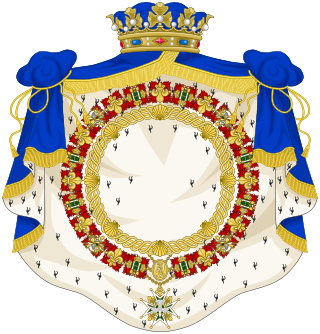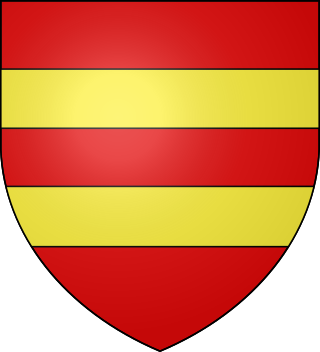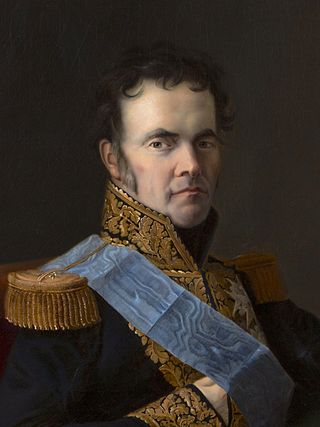
André Marie Jean Jacques Dupin, commonly called Dupin the Elder, was a French advocate, president of the chamber of deputies and of the Legislative Assembly.

The Peerage of France was a hereditary distinction within the French nobility which appeared in 1180 during the Middle Ages.

Jacques Laffitte was a leading French banker, governor of the Bank of France (1814–1820) and liberal member of the Chamber of Deputies during the Bourbon Restoration and July Monarchy. He was an important figure in the development of new banking techniques during the early stages of industrialization in France. In politics, he played a decisive role during the Revolution of 1830 that brought Louis-Philippe, the duc d'Orléans, to the throne, replacing the unpopular Bourbon king Charles X.

The July Monarchy, officially the Kingdom of France, was a liberal constitutional monarchy in France under Louis Philippe I, starting on 26 July 1830, with the July Revolution of 1830, and ending 23 February 1848, with the Revolution of 1848. It marks the end of the Bourbon Restoration (1814–1830). It began with the overthrow of the conservative government of Charles X, the last king of the main line House of Bourbon.

The Senate is the upper house of the French Parliament, with the lower house being the National Assembly, the two houses constituting the legislature of France. The French Senate is made up of 348 senators elected by part of the country's local councillors, as well as by representatives of French citizens living abroad. Senators have six-year terms, with half of the seats up for election every three years.

Étienne-Denis, duc de Pasquier, Chancelier de France,, was a French statesman. In 1842, he was elected a member of the Académie française, and in the same year was created a duke by Louis-Philippe.
The Ultra-royalists were a French political faction from 1815 to 1830 under the Bourbon Restoration. An Ultra was usually a member of the nobility of high society who strongly supported Roman Catholicism as the state and only legal religion of France, the Bourbon monarchy, traditional hierarchy between classes and census suffrage, while rejecting the political philosophy of popular will and the interests of the bourgeoisie along with their liberal and democratic tendencies.
During the Bourbon Restoration (1814–1830) and the July Monarchy (1830–1848), the Doctrinals were a group of French royalists who hoped to reconcile the monarchy with the French Revolution and power with liberty. Headed by Royer-Collard, these liberal royalists were in favor of a constitutional monarchy, but with a heavily restricted census suffrage—Louis XVIII, who had been restored to the throne, had granted a Charter to the French with a Chamber of Peers and a Chamber of Deputies elected under tight electoral laws. The Doctrinaires were a centrist, as well as a conservative-liberal group, but at that time, liberal was considered to be the mainstream political left, so the group was considered a centre-left group.

The Anti-Sacrilege Act (1825–1830) was a French law against blasphemy and sacrilege passed in April 1825 under King Charles X. The death penalty provision of the law was never applied, but a man named François Bourquin was sentenced to perpetual forced labour for the sacrilegious burglary of Eucharistic objects; the law was later revoked at the beginning of the July Monarchy under King Louis-Philippe.

The House of Harcourt is a Norman family, and named after its seigneurie of Harcourt in Normandy. Its mottos were "Gesta verbis praeveniant", "Gesta verbis praevenient", and "Le bon temps viendra ... de France".

Pierre-Marc-Gaston de Lévis, second duke of Lévis, peer of France, was a French politician, aphorist, and soldier. At the French Revolution he was a deputy of the National Constituent Assembly. He published several books and was a member of the Académie française.

The Second White Terror occurred in France in 1815–1816, following the defeat of Napoleon at the Battle of Waterloo and the enthronement of Louis XVIII as King of France after the Hundred Days. Suspected sympathizers of the French Revolution, Republicans, Bonapartists and, to a minor degree, Protestants, suffered persecution. Several hundred were killed by angry mobs or executed after a quick trial at a drumhead court-martial.

Philibert-Jean-Baptiste François Joseph, comte Curial was a general in the French Imperial Army during the Napoleonic Wars.

Joseph Mérilhou was a French lawyer, magistrate and politician. He was Minister of Public Education and Religious Affairs, and then Minister of Justice in the Cabinet of Jacques Laffitte.

Ambroise-Polycarpe de La Rochefoucauld GE, 1st Duke of Doudeauville, was a French soldier and politician. He was Minister of the Royal Household from 1821 to 1827.

Édouard de Fitz-James, 6th Duke of Fitz-James was a French soldier, politician, Peer of France, and 6th Duke of Fitz-James, who descended from the British House of Stuart.

Louis François Sosthènes I de La Rochefoucauld, Viscount of La Rochefoucauld, 2nd Duke of Doudeauville GE, was a 19th-century French ultra-royalist politician. From 1814 to 1836, he was aide-de-camp to Charles, Count of Artois and from 1824 to 1830, the King's Director of Fine Arts. He served in the Chamber of Deputies in 1815 and from 1827 to 1830 during the Bourbon Restoration, until his retirement from public life after the July Revolution in 1830. From 1861 to 1864 he published his memoirs with his correspondence in fifteen volumes.
Anne-Alexandre-Marie-Sulpice-Joseph de Montmorency-Laval, 2nd Duke of Laval was a French politician and soldier.

Marie-François-Emmanuel de Crussol, 10th Duke of Uzès, was a French soldier and politician.































